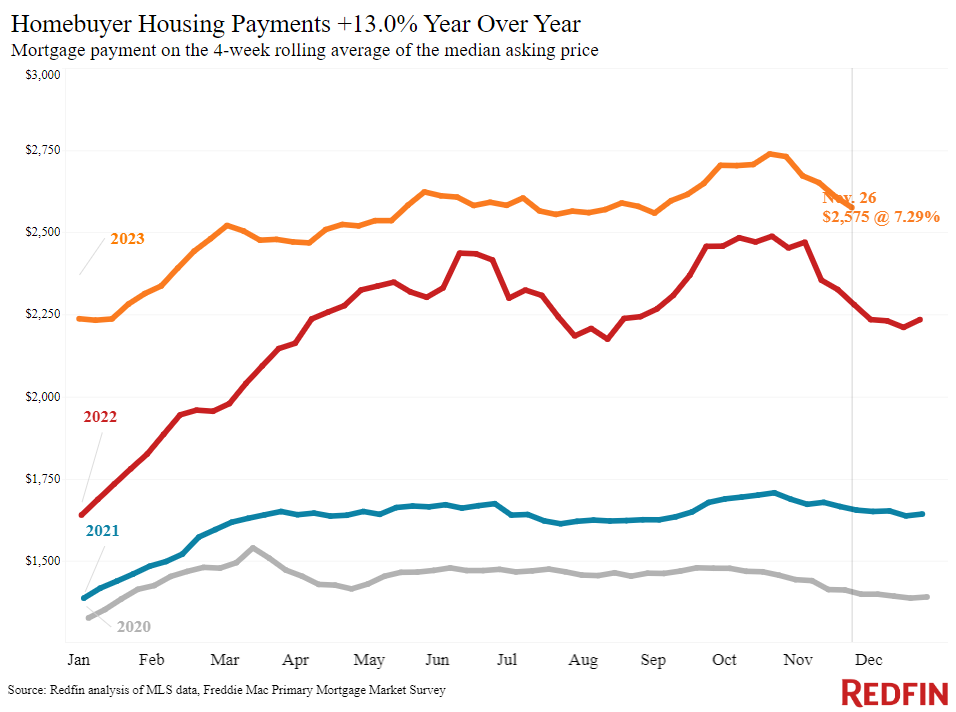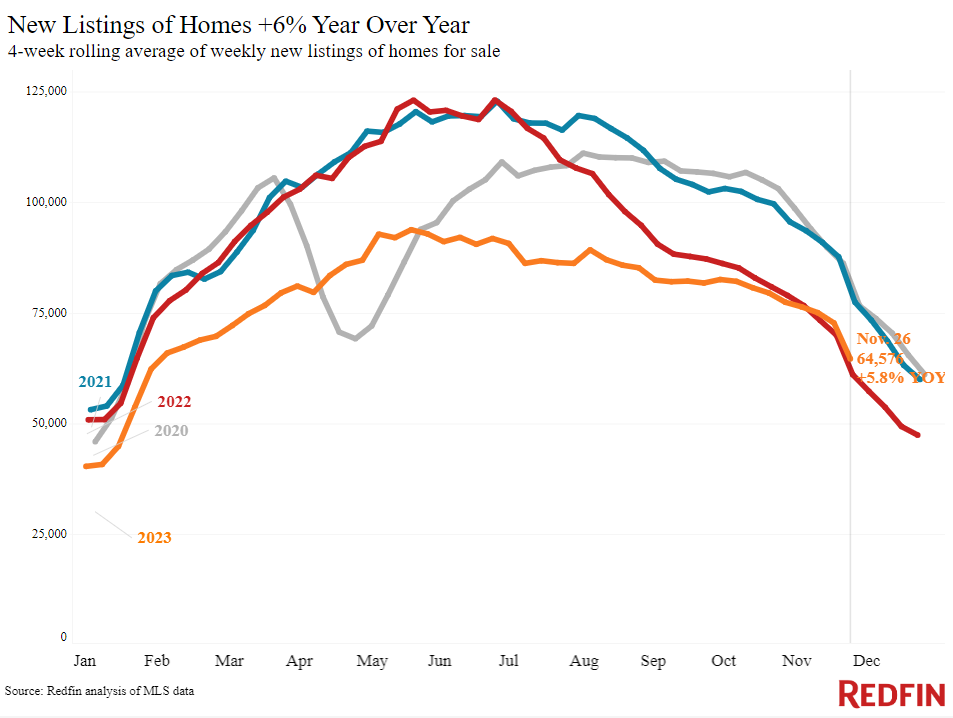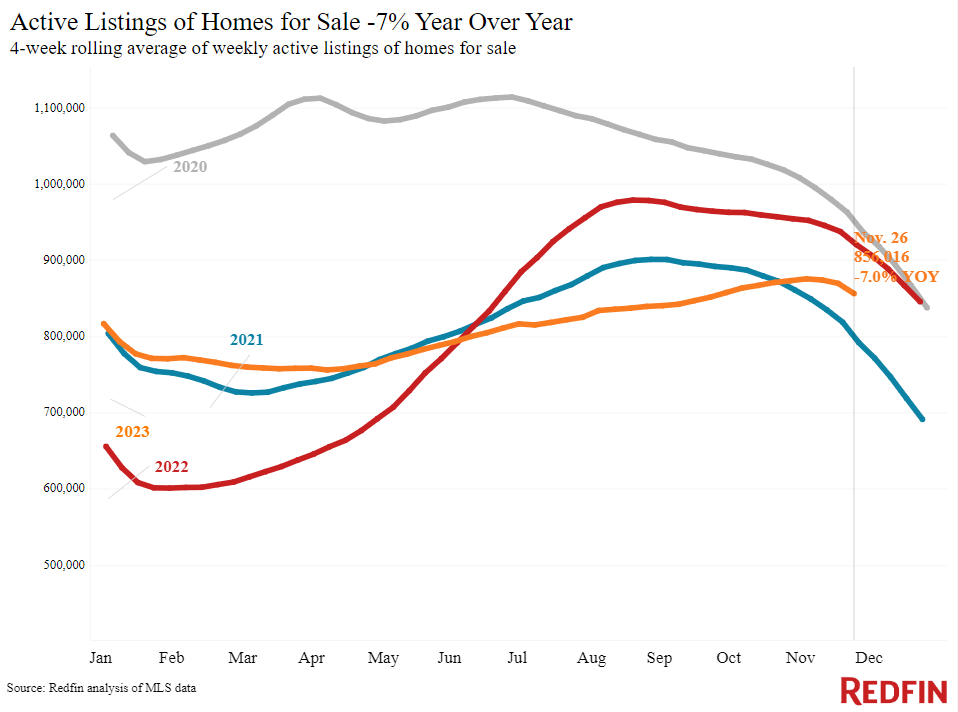Housing payments have declined for the fifth week in a row, according to a new report from Redfin. The typical U.S. homebuyer’s monthly mortgage payment was $2,575 during the four weeks ending November 26, down $164 from a peak of $2,739 last month but up 13% year-over-year (YoY).
Monthly payments are falling from their peak because mortgage rates are falling from their peak. The weekly average 30-year mortgage rate is 7.29%, down from a high of 7.79% in October, and the daily average is 7.13% as of November 29, its lowest level since the start of September. Rates have declined enough to offset rising home prices; the median sale price is up 4%.

Prices are up because inventory is low; the total number of homes for sale is down 7% year over year. But there is hope for buyers wanting more homes to choose from: New listings are up 6%, the biggest year-over-year uptick in over two years. Buyers are taking note of slightly improved conditions: Mortgage-purchase applications are up 5% week over week.
"Mortgage rates are dropping due to easing inflation and investors betting the Fed will cut interest rates sooner than expected," said Redfin Economics Research Lead Chen Zhao. "Declining rates, along with a sizable year-over-year increase in new listings, are leading to more favorable conditions for some buyers."
Leading indicators of homebuying demand and activity:
- The weekly average 30-year fixed mortgage rate was 7.29% for the week ending Nov. 22, down from a two-decade high of 7.79% a month earlier, representing the fourth straight week of declines, and p from 6.61%, according to Freddie Mac.
- Mortgage-purchase applications were up 5% from a week earlier as of the week ending Nov. 24, and down 19%, according to the Mortgage Bankers Association (MBA).
- The Redfin Homebuyer Demand Index was down 2% from a month earlier as of the week ending Nov. 26, and down 5%, according to Redfin.
- Google searches for “home for sale” were down 13% from a month earlier as of Nov. 25, and remained flat, according to Google Trends.
- Touring activity was down 38% from the start of the year as of Nov. 23. At this time last year, it was down 40% from the start of 2022, according to ShowingTime.

Key housing-market data for the four weeks ending November 26, 2023:
- The median sale price was $364,730, with a 4.2% YoY change. Prices are up partly because elevated mortgage rates were hampering prices during this time last year.
- The median asking price was $371,225, with a 6% YoY change.
- The median monthly mortgage payment $2,575 at a 7.29% mortgage rate, representing a 13% YoY change, and down $164 from all-time high set a month earlier. This represented the lowest level in three months.
- Pending sales were 61,217, representing a -6.9% YoY change.
- New listings were 64,576, representing a 5.8% YoY change, the biggest uptick in over two years. The increase is partly because new listings were falling at this time last year.
- Active listings were 856,016, representing a -7% YoY change, the smallest decline since June.
- The months supply of homes was 4.2 months, representing a +0.1 pt YoY change. Four to five months of supply is considered balanced, with a lower number indicating seller’s market conditions.
- The share of homes off the market in two weeks was 33.7%, up from 30%.
- Median days on market was 35, down -2 days YoY.
- The share of homes sold above list price was 27.3%, up from 26% YoY.
- The share of homes with a price drop was 5.7%, up +0.3 pts YoY.
- The average sale-to-list price ratio was 98.8%, up +0.4 pts YoY, representing the lowest level since April.

Metro-level highlights for the four weeks ending November 26, 2023:
The average U.S. median sales price declined in seven U.S. metros.
Metros with biggest YoY increases in median sale price:
- Anaheim, CA (19.3%)
- San Diego, CA (13%)
- Cincinnati, OH (12.3%)
- Miami (10.5%)
- Providence, RI (9.9%)
Metros with biggest YoY decreases in median sale price:
- Austin, TX (-9.2%)
- San Antonio, TX (-1.7%)
- Portland, OR (-1.3%)
- Detroit (-0.8%)
- Houston (-0.5%)
Overall pending sales increased in three U.S. metros.
Metros with biggest YoY increases in pending sales:
- San Jose, CA (15.3%)
- Columbus, OH (3.7%)
- Detroit (1.3%)
Metros with biggest YoY decreases in pending sales:
- Cincinnati, OH (-21.9%)
- New York (-18.7%)
- New Brunswick, NJ (-15.4%)
New listings declined in 14 metros across the U.S.
Metros with biggest YoY increases in new listings:
- Orlando, FL (22.5%)
- San Jose, CA (21.5%)
- Phoenix (16.9%)
- West Palm Beach, FL (16.7%)
- Houston (13.4%)
Metros with biggest YoY decreases in new listings:
- Atlanta (-14.9%)
- San Francisco (-11.7%)
- Seattle (-11%)
- Providence, RI (-8.4%)
- Portland, OR (-6.8%)
"My advice for serious homebuyers is to compare housing costs to recent highs instead of long-ago lows," said Zhao. "Housing costs are at their lowest level in three months, and it's unlikely they will drop significantly anytime soon. That makes it a relatively good time to lock in a rate."
To read the full report, including more data, charts, and methodology, click here.

 DSNews The homepage of the servicing industry
DSNews The homepage of the servicing industry









